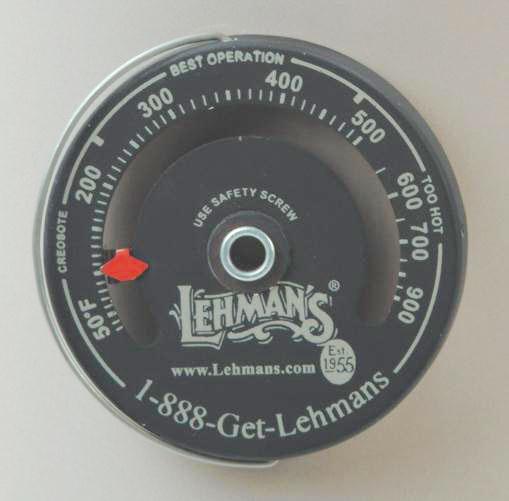
“Heating without a stovepipe thermometer is like driving without a speedometer.”
That’s what it said on the package, and I thought it was kind of funny, but after just a couple days with my thermometer attached to the stovepipe in my greenhouse, I can’t imagine how I ever did without it. It was a major guessing game before, I can tell you that!
Here’s how it works: the thermometer magnetically attaches to my single-walled stovepipe, about 12 inches above where the stovepipe exits the burning chamber. The thermometer shows the temperature at that spot, with convenient and helpful statements: “Creosote” below about 225 degrees F, “Too Hot” above 475 degrees F, and “Best Operation” for the sweet spot in between.

The principles are simple: if your fire is burning too cool, there’s a good chance that incomplete combustion is happening and creosote is forming on the inside of the chimney. A couple friends of mine lost a greenhouse full of seedlings when creosote blocked their chimney entirely and smoke spilled in and suffocated their plants—a sad story to be sure, but better plants than people! Before I had a stovepipe thermometer, I had no way of knowing if my fire was hot enough to avoid making creosote, and I have to admit that, in pursuit of a slow fire to keep burning overnight, I probably kept it a bit too cool.
A too-hot fire is less dangerous than a too-cool fire, actually—it’s just inefficient. There’s too much heat to radiate out, and those years of collected sunlight in the firewood just zoom up and out the chimney, unused. My thrifty self balks against that! I want to use every atom of heat I can get.
My main use of wood heat is in my greenhouse, which is not near my house. On test-run nights, I’ve been sleeping in the greenhouse to get up and monitor the fire periodically, but in general I would like to light a fire and be done with it for the night. I’ve got lots of variables to deal with—the outside overnight low, the type of wood I have access to (this year, mostly small aged pine logs), my dampers, length of time I want the fire to burn, etc. There’s a lot of guesswork, but the stovepipe thermometer gives me a much needed measure to inform my tinkering. Without it, managing a fire is a shot in the dark.
Raised in the city, but now farming solo in the Midwest, Hannah reviews products and shares her adventures periodically with Country Life.





























